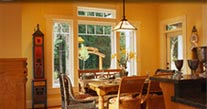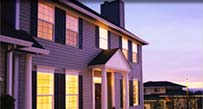Please Note! This is our archived old board, it is “read only.”
To visit our current active discussion board click below.
https://www.replacement-windows.com/windowbb/
| Author: | Ed |
| Subject: | Tempered / Laminated |
| Posted At: | 2004-08-17 19:09:59 |
All You Glass Experts What do you think.
Tempered vs. Laminated Pros/Cons
Oberon, FenEx People must have oppinions
on this.
I kinda think I like one of each in an IG
unit.
Seems like this would be the best for
sound and UV reduction as well as
strength.
Ed
| Author: | FenEx |
| In Reply To: | Tempered / Laminated (posted by Ed) |
| Subject: | RE: Tempered / Laminated |
| Posted At: | 2004-08-17 20:20:27 |
Oberon is the Glass dude. I am sure he will post enough information for you to read well into your 90's and still give your grandchildren plenty of new material while learning to read while they get through the remains of the post (hehehe). With that ahead of you... I'll give you a simple input.
Tempered is hardened by heat so it's stronger... and the process creates stress fractures in the glass. So, in short, if it does break, it crumbles into small pieces instead of dangerous shards of glass. Laminated glass, can also be tempered glass, but with or without tempering it is attached to either a film or a liquid resin layer to keep the broken pieces in place to avoid injury.
I am not sure about sound differences with either over standard glass as they will all transmit. The amount of dead air space between the panes appears to have the greatest effect. As for UV reduction, the long wave radiation (heat) is deflected by Low-E coatings and has nothing to do with the strength of the glass.
| Author: | Oberon |
| In Reply To: | Tempered / Laminated (posted by Ed) |
| Subject: | RE: Tempered / Laminated |
| Posted At: | 2004-08-17 20:59:02 |
Tempered versus laminated. And where would you get the idea that I (or FenEx!) might have an opinion on this subject?
First, both products meet the requirements of the safety glazing instructions, both ANSI Z97.1 and CPSC 16CFR1201…which really doesn’t tell anyone reading this a heck of a lot…other than the regulatory agencies consider both products to be safety glazing.
I am going to stick in a quick editorial here…many people see wire-glass and immediately think of that as a safety glazing product….DON’T!
Wire glass is not an impact safe product. It is actually about half as strong as ordinary annealed and is very dangerous stuff. NEVER push open a door by pushing directly on wire-glass…it isn’t safe.
There are a bunch of lawsuits pending over people being seriously hurt or even killed by that stuff.
Okay, back to the original subject.
Tempered glass is a single lite, of whatever thickness, that is heated up to 1200 degrees F and then rapidly cooled using high pressure air blown over the surface of the glass – this process is called “quenching”.
When the glass is “forced” cooled during the quenching process, the outer section of the lite cools very rapidly, but the interior of the lite stays very hot. Hot glass expands. Cool glass contracts. When both processes are happening simultaneously, this produces extreme stress in the glass. As the center section of the lite cools it causes significant compression in the outer layer of the glass and also results in tension in the center of the lite. In order to break tempered glass, you have to completely penetrate the compression layer and “release” the tension in the center. When you do that …BANG! Millions of little pieces of glass all over the place.
Consider tempered glass to have about four times the break strength as annealed. Tempered glass must be a minimum surface compression of 10,000psi, or more, and an edge compression of 9700psi, or more. Float glass will have a surface compression down around 2500psi or so.
Typical break stress of tempered glass is around 24,000psi and typical break stress of annealed glass is around 6000psi or so.
Laminated glass is two lites of glass bonded together using a plastic interlayer. The “glass” in laminated glass can be annealed, heat strengthened, or tempered.
Generally, tempered laminate is not recommended because of optical distortion.
Tempering will cause some optical distortion in glass. It is part of the process and impossible to avoid. When a manufacturer combines two lites of tempered glass in a laminate, that distortion is magnified considerably and the resulting product can look really bad.
The primary advantage of tempered glass is that it has the very strong surface compression layer. A baseball impact to tempered will probably bounce off and the glass will be intact. A second major advantage is that tempered glass has significantly greater resistance to thermal stress. But, if tempered does break, you have a big hole in your wall where the glass used to be!
Ordinary annealed window glass is subject to thermal stress breakage. Tempering pretty much eliminates that from happening.
The primary advantage of laminated glass is that if it is broken (and it will break easier than tempered) then you have a broken window but the glass stays in place.
Your car has a laminated windshield and tempered side and rear windows. I suspect everyone has seen a cracked windshield…but no one has ever seen a “cracked” side window. If the side window cracks, it is gone.
Ed, your suggestion of using tempered and laminate on both sides of an IG is a very good one. It will result in a very strong window with excellent acoustic properties and a few other less obvious advantages as well.
Although laminated glass does not result in an increase in energy efficiency greater than that of annealed of the same thickness, one of the properties of the interlayer is that it blocks some 99.9% of UV light. This is substantially better than any Low-E on the market. Which does not mean that laminated can replace Low-E, they perform different functions, but if you want full UV protection, then laminated is the way to go.
Laminated also helps considerably in sound attenuation. I have read on this site and in a few other places that sales-folk sometimes suggest tempered to help with sound control or even energy efficiency – sorry, tempering will not affect either to a noticeable degree.
Okay, as usual this is way too long, but it is fun for me, so what the heck!
If anyone has questions, feel free to ask!
| Author: | Ed |
| In Reply To: | RE: Tempered / Laminated (posted by Oberon) |
| Subject: | RE: Tempered / Laminated |
| Posted At: | 2004-08-17 23:00:50 |
Thanks for the reply.
You confirmed some of my thoughts.
I have been thinking of using some of the
Simonton Storm Breaker windows.
Tempered outer, laminated inner.
Just trying to think why this would
not be a good idea other than $
and they are heavier. Just ordered
a sample one to see how it looks.
Thanks again,
Ed
| Author: | Guy |
| In Reply To: | RE: Tempered / Laminated (posted by Ed) |
| Subject: | RE: Tempered / Laminated |
| Posted At: | 2004-08-19 12:13:21 |
Heavy isn't the word for it. Wear your lifting belt for sure. Great post Oberon! Your in depth knowledge is fabulous. You've probably forgot more than most people know. I know I do a lot of commercial door and hardware replacements. The ADA codes still keep me busy. Wire glass has been used for years as a safety glass. It's been changing over quickly. Nothing like a sharp edged super egg skicer to fillet your arm. It's some tough stuff though. I've tried to smash a hammer through it many of times. Lots of glass splinters and shards. Is it true they only melt the wire in the glass outside the US? Some one told me it produces a nasty gas when making this product. En-lighten me Obi-one. Your friend,
Young Luke S.
| Author: | JohnAM |
| In Reply To: | RE: Tempered / Laminated (posted by Oberon) |
| Subject: | RE: Tempered / Laminated |
| Posted At: | 2004-08-20 05:20:27 |
Based on your explanation,wouldn't 2 lites of laminated glass give you the ultimate sound, strength & UV qualities?





